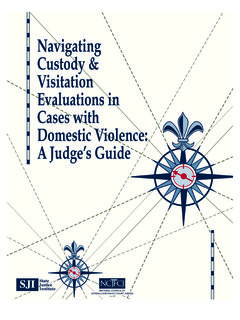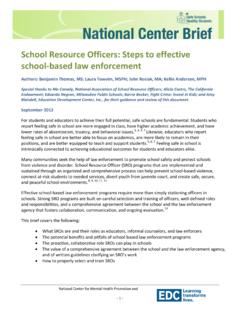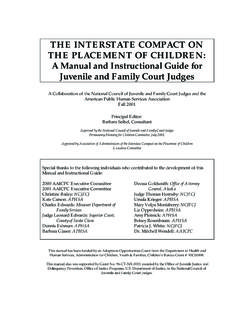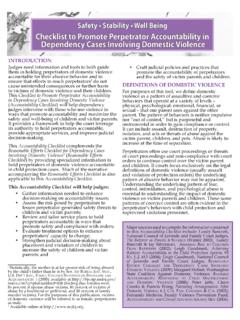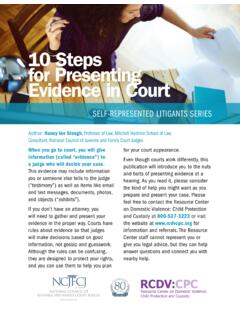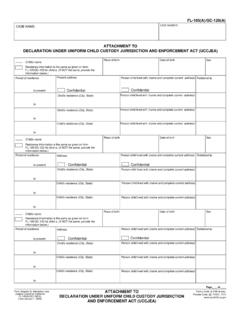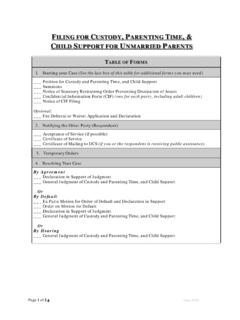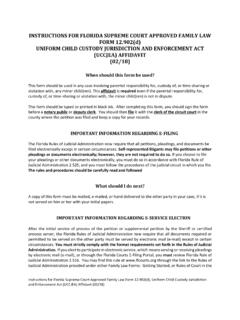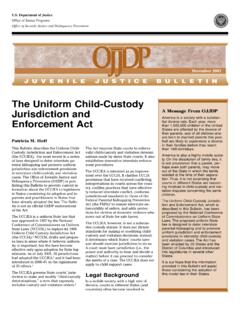Transcription of Uniform Child Custody Jurisdiction and Enforcement Act ...
1 Uniform Child Custody Jurisdiction AND Enforcement ACT: GUIDE FOR COURT PERSONNEL AND JUDGES Uniform Child Custody Jurisdiction and Enforcement ActGUIDE FOR COURT PERSONNEL AND JUDGESUNIFORM Child Custody Jurisdiction AND Enforcement ACT: GUIDE FOR COURT PERSONNEL AND JUDGES This guide was supported by Grant No. 2016-TA-AX-K030 awarded by the Office on Violence Against Women, Department of Justice. The opinions, findings, conclusions, and recommendations expressed in this presentation are those of the authors and do not necessarily reflect the views of the Department of Justice, Office on Violence Against Child Custody Jurisdiction AND Enforcement ACT: GUIDE FOR COURT PERSONNEL AND JUDGES Interstate Custody cases involving domestic violence arrive at the courthouse in a variety of ways: A victim of domestic violence who has fled for safety from another state seeks an emergency Custody order from your court.
2 A left-behind parent files for Custody in your court, seeking the return of the children from another state. A victim with a Custody order from another state seeks Enforcement of the order in your state because the other parent has refused to return the children. A victim with a Custody order from another state seeks a modification from your court because the other parent has been abusive during visitation with the children. A victim from another state seeks a protection order with a Custody provision. A protection order from one state and a Custody order from another contain conflicting provisions regarding the guide, developed by the Legal Resource Center on Violence Against Women, the National Center on State Courts, and the National Council of Juvenile and Family Court Judges, is intended to help you to determine whether your court has Jurisdiction to enter or modify a Child Custody order in these and other interstate cases, as well as to understand your responsibilities to enforce orders from other jurisdictions .
3 The guide includes four components: (1) an overview of the Uniform Child Custody Jurisdiction and Enforcement Act (the UCCJEA), a Uniform state law that governs decision-making about Jurisdiction in interstate Custody cases; (2) a practice guide for judicial officers that includes strategies for effective implementation of the UCCJEA in your court; (3) a similar practice guide for non-judicial court personnel; and (4) a copy of the UCCJEA and a chart with citations to state versions of the you have any questions about the information presented in these materials, or about interstate Custody cases involving domestic violence, please do not hesitate to call the Legal Resource Center at 301-270-1550. 1 INTRODUCTIONUNIFORM Child Custody Jurisdiction AND Enforcement ACT: GUIDE FOR COURT PERSONNEL AND JUDGES 2 The UCCJEA is a Uniform state law drafted by the National Conference of Commissioners on Uniform State Laws (now the Uniform Law Commission) and enacted by all states (with the exception of Massachusetts), the District of Columbia, Guam, and the Virgin Islands.
4 The UCCJEA addresses a court s subject matter Jurisdiction in Child Custody cases, specifically answering the question of whether a court has the power to decide a Custody case in which more than one state, tribe, or territory is involved. The law specifies which court has the power to decide a Custody case, not how the court should decide the case, which is governed by the Jurisdiction s general Child Custody following flowchart provides a step-by-step approach to determining whether a court has Jurisdiction over a Custody case under the UCCJEA:1. Is there an emergency? (temporary emergency Jurisdiction )2. Is there an existing Custody order and/or Custody proceeding in another state? If so, do I have Jurisdiction to modify any orders or to issue a new order?
5 3. If there is no emergency or existing order/proceeding, do I have initial Child Custody Jurisdiction ?4. If I have Jurisdiction to enter an initial Custody order or to modify an existing order, should I decline to do so?5. Are there any additional considerations?OVERVIEW OF THE Uniform Child Custody Jurisdiction AND Enforcement ACTUNIFORM Child Custody Jurisdiction AND Enforcement ACT: GUIDE FOR COURT PERSONNEL AND JUDGES 3 STEP 1: Is there an emergency? Temporary Emergency Jurisdiction Judicial CommunicationTemporary Emergency JurisdictionUnder the UCCJEA, a court may exercise temporary emergency Jurisdiction when the Child has been abandoned or it is necessary in an emergency to protect the Child because the Child or a sibling or parent of the Child is subjected to or threatened with mistreatment or abuse.
6 UCCJEA, 204. A court may do so even if another court has preferred Jurisdiction for the long-term Custody provision clarifies that a court may exercise temporary emergency Jurisdiction when a parent (or sibling) of a Child has been abused or threatened with abuse, even if the Child herself or himself has not been abused. Consequently, a court can exercise this form of Jurisdiction when there is evidence that the parent has been abused by the other parent without requiring a finding that there is any Child mistreatment or abuse. To exercise emergency Jurisdiction , however, a court must find that the Child is present in the state. A court may exercise temporary emergency Jurisdiction by entering a domestic violence protection order that includes a Custody provision (or through another procedural vehicle).
7 The UCCJEA specifies that emergency Jurisdiction is temporary; it is available to protect the parties until a court in the state with preferred Jurisdiction is aware of the emergency and in a position to issue an order or to decline Jurisdiction in favor of another state. In limited circumstances, however, it can become permanent if the order so states, provided a Child Custody proceeding has not been commenced in another state with Jurisdiction and the state becomes the Child s home Communication An exercise of emergency Jurisdiction triggers mandatory judicial communication between the issuing court and any court in another Jurisdiction that is hearing an existing Custody case or has issued a Custody order involving the same parties.
8 The purpose of the communication is to resolve the emergency, protect the parties and Child , and determine the duration of the emergency order. Ultimately, the court with preferred Jurisdiction has the authority to issue or modify a long-term Custody order, though it may decline to do so on inconvenient forum grounds (see Step 4). Uniform Child Custody Jurisdiction AND Enforcement ACT: GUIDE FOR COURT PERSONNEL AND JUDGES Modifying an OrderThe court that originally issued a Custody order retains continuing exclusive Jurisdiction over any modifications of that order. UCCJEA, 202. A court in a different state may modify the order (provided it has Jurisdiction ) under four circumstances:1. Upon a finding by the issuing court or the new court that all of the parties have left the issuing state; or 2.
9 Upon a finding by the issuing court that the parties no longer have a significant connection with the state and that substantial evidence is no longer available there; or3. Upon a decision by the issuing court to decline to exercise Jurisdiction in favor of another state (see Step 4); or4. Upon a finding by the new court that it has grounds to exercise temporary emergency 2: Is there an existing Custody order and/or Custody proceeding in another state? If so, do I have Jurisdiction to modify any orders or to issue a new order? Uniform Child Custody Jurisdiction AND Enforcement ACT: GUIDE FOR COURT PERSONNEL AND JUDGES 5 STEP 3: If there is no emergency or existing order/proceeding, do I have initial Child Custody Jurisdiction ?
10 Initial Child Custody Jurisdiction Home State Jurisdiction Significant Connection Jurisdiction More Appropriate Forum No Other State or Vacuum JurisdictionInitial Child Custody JurisdictionThe UCCJEA sets forth four jurisdictional bases to help a court determine whether it has initial Child - Custody Jurisdiction over a Custody matter (in addition to temporary emergency Jurisdiction , described above in Step 1). UCCJEA, 201. These four bases for initial Child Custody Jurisdiction are: 1. Home state;2. Significant connection;3. More appropriate forum; and4. No other state or vacuum. The UCCJEA establishes a hierarchy among the four jurisdictional bases, prioritizing home state State JurisdictionThe UCCJEA defines the home state as the state in which a Child lived with a parent or a person acting as a parent for at least six consecutive months immediately before the commencement of a Child Custody proceeding.
